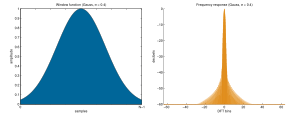Window function facts for kids
A window function is a special mathematical tool used in areas like digital signal processing. Think of it like a "window" that lets you see only a specific part of a longer signal or sound.
Imagine you have a very long song, and you only want to listen to a small part of it. A window function helps you pick out just that section. It works by making everything outside the chosen part become zero, so only the "windowed" section remains.
Contents
What is a Window Function?
In mathematics, a window function is a special type of function. It has a value of zero outside a specific area, and a non-zero value inside that area. When you multiply a signal (like a sound wave or an electrical signal) by a window function, it's like putting a frame around a picture. Everything outside the frame disappears, and you only see what's inside.
The simplest window function is called the rectangular window (also known as the Dirichlet window). It's like a simple on/off switch: it's "1" (fully on) inside the area you're interested in, and "0" (fully off) everywhere else.
Most window functions are symmetrical around their center. They can make the signal stronger or weaker at different points within the "window." This helps to analyze signals more clearly, especially when looking at their different frequencies.
Why Do We Use Window Functions?
Window functions are very useful when you want to analyze a signal that goes on for a long time, but you only have a short recording of it. For example, if you're studying a sound, you might record only a few seconds.
When you analyze this short recording, the sudden start and end can create problems. It's like cutting a song in the middle of a note – it sounds choppy. Window functions help to smooth out these sudden changes. They gently fade the signal in and out at the edges of your chosen section. This makes the analysis much more accurate and avoids confusing "fake" signals that can appear from the sudden cuts.
Different Types of Window Functions
There are many different types of window functions, each with its own shape and properties. Some common ones include:
- Rectangular Window: The simplest one, like an on/off switch. It's good for some things but can cause problems with accuracy.
- Hann Window (or Hanning Window): This one has a smooth, bell-like shape. It's very popular because it helps to reduce unwanted effects when analyzing signals.
- Hamming Window: Similar to the Hann window, but designed to be even better at reducing certain types of errors.
- Gauss Window: Shaped like a Gauss curve, which is a common bell-shaped curve in statistics.
Each type of window function is chosen depending on what kind of signal you are analyzing and what you want to achieve with your analysis.
Images for kids
See also
 In Spanish: Ventana (función) para niños
In Spanish: Ventana (función) para niños





